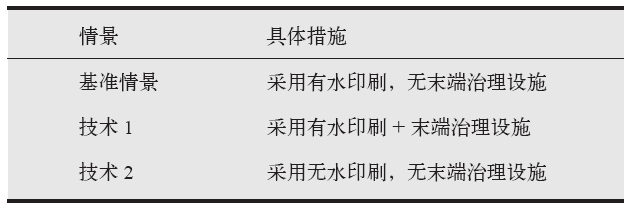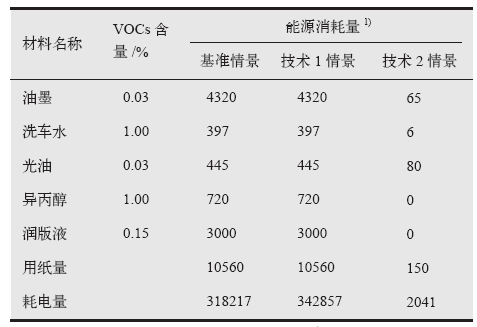| [1] |
杨利娴, 黄萍, 赵建国, 等. 我国印刷业VOCs污染状况与控制对策[J]. 包装工程, 2012,33(3):125-131.
|
|
Yang L X, Huang P, Zhao J G, et al. Current status and control strategies of VOC emission from printing industry[J]. Packaging Engineering, 2012,33(3):125-131 (in Chinese)
|
| [2] |
王海林, 王俊慧, 祝春蕾, 等. 包装印刷行业挥发性有机物控制技术评估与筛选[J]. 环境科学, 2014,35(7):2503-2507.
|
|
Wang H L, Wang J H, Zhu C L, et al. Evaluation and selection of VOCs treatment technologies in packaging and printing industry[J]. Environmental Science, 2014,35(7):2503-2507 (in Chinese)
|
| [3] |
中国印刷及设备器材工业协会. 中国印刷及设备器材工业协会七届四次理事会胜利召开[EB/OL]. 2018 [2020-01-01]. https://www.sohu.com/a/280038897_100015058.
|
|
China Printing. Scientific and Technological Innovation and Application [EB/OL]. 2018 [2020-01-01]. https://www.sohu.com/a/280038897_100015058.
|
| [4] |
张炽辉. 印刷行业VOCs研究与治理[J]. 科技创新与应用, 2018,4:177-178.
|
|
Zhang C H. Research and management of VOCs in printing industry[J]. Scientific and Technological Innovation and Application, 2018,4:177-178 (in Chinese)
|
| [5] |
敖伊敏, 庞小平, 梁宏宇. 印刷行业VOCs研究与治理[J]. 资源节约与环保, 2019,8:78.
|
|
Ao Y M, Pang X P, Liang H Y. Research and management of VOCs in printing industry[J]. Resource Conservation and Environmental Protection, 2019,8:78 (in Chinese)
|
| [6] |
毛显强, 曾桉, 胡涛, 等. 技术减排措施协同效应评价研究[J]. 中国人口?资源与环境, 2011,21(12):1-7.
|
|
Mao X Q, Zeng A, Hu T, et al. Study of coordinate control effect assessment of technological measures for emissions reduction[J]. China Population, Resources and Environment, 2011,21(12):1-7 (in Chinese)
|
| [7] |
胡注娇. 印刷环境管理及基于无水印刷的环保印刷解决方案[J]. 今日印刷, 2003,12:42-45.
|
|
Hu Z J. Printing environment management and environmental protection printing solution based on waterless printing[J]. Print Today, 2003,12:42-45 (in Chinese)
|
| [8] |
顾阿伦, 滕飞, 冯相昭. 主要部门污染物控制政策的温室气体协同效果分析与评价[J]. 中国人口?资源与环境, 2016,26(2):10-17.
|
|
Gu A L, Teng F, Feng X Z. Assessment and analysis on co-benefits of pollution control and greenhouse gases emission reduction in key sectors[J]. China Population, Resources and Environment, 2016,26(2):10-17 (in Chinese)
|
| [9] |
周颖, 张宏伟, 蔡博峰, 等. 水泥行业常规污染物和二氧化碳协同减排研究[J]. 环境科学与技术, 2013,36(12):164-168.
|
|
Zhou Y, Zhang H W, Cai B F, et al. Synergetic reduction of local pollutants and CO2 from cement[J]. Environmental Science & Technology, 2013,36(12):164-168 (in Chinese)
|
| [10] |
Tan Q L, Wen Z G, Chen J N. Goal and technology path of CO2 mitigation in China’s cement industry: from the perspective of co-benefit[J]. Journal of Cleaner Production, 2016,114:299-313
doi: 10.1016/j.jclepro.2015.06.148
URL
|
| [11] |
刘胜强, 毛显强, 胡涛, 等. 中国钢铁行业大气污染物与温室气体协同控制路径研究[J]. 环境科学与技术, 2012,35(7):168-174.
|
|
Liu S Q, Mao X Q, Hu T, et al. Roadmap of co-control of air pollutants and GHGs in iron and steel industry in China[J]. Environmental Science & Technology, 2012,35(7):168-174 (in Chinese)
|
| [12] |
陶学宗, 吴琴, 尹传忠. 绿色交通目标下集装箱“公转铁”的CO2减排潜力评估[J]. 气候变化研究进展, 2019,15(6):660-669.
|
| [13] |
Tao X Z, Wu Q, Yin C Z. CO2 reduction potential of shifting containers from road to rail for green transport development[J]. Climate Change Research, 2019,15(6):660-669 (in Chinese)
|
| [14] |
Alam M S, Hyde B, Duffy P, et al. Analysing the co-benefits of transport fleet and fuel policies in reducing PM2.5 and CO2 emissions[J]. Journal of Cleaner Production, 2018,172:623-634
doi: 10.1016/j.jclepro.2017.10.169
URL
|
| [15] |
李丽平, 周国梅, 季浩宇. 污染物减排的协同效应研究: 以攀枝花市为例[J]. 中国人口?资源与环境, 2010,20(5):91-95.
|
|
Li L P, Zhou G M, Ji H Y. Study of co-benefits assessment of pollution reduction: a case study in Panzhihua[J]. China Population, Resources and Environment, 2010,20(5):91-95 (in Chinese)
|
| [16] |
Dong H J, Dai H C, Dong L, et al. Pursuing air pollutant co-benefits of CO2 mitigation in China: a provincial leveled analysis[J]. Applied Energy, 2015,144:165-174
doi: 10.1016/j.apenergy.2015.02.020
URL
|
| [17] |
Thompson T M, Rausch S, Sarri R K, et al. Air quality co-benefits of subnational carbon policies[J]. Journal of the Air & Waste Management Association, 2016,66(10):998-1002
|
| [18] |
陈长虹, 王冰妍. 中国能源政策的大气污染物减排效果与附加效应: 上海案例研究[J]. 上海环境科学, 2003,22(10):682-686.
|
| [19] |
Chen C H, Wang B Y. Local air pollutant emission reduction and co-benefit of China energy policy: Shanghai case study[J]. Shanghai Environmental Sciences, 2003,22(10):682-686 (in Chinese)
|
| [20] |
谭琦璐, 温宗国, 杨宏伟. 控制温室气体和大气污染物的协同效应研究评述及建议[J]. 环境保护, 2018,24:51-57.
|
|
Tan Q L, Wen Z G, Yang H W. Review and recommendations on the co-benefit effects of controlling greenhouse gases and atmospheric pollutants[J]. Environmental Protection, 2018,24:51-57 (in Chinese)
|
| [21] |
生态环境部. 关于发布《工业企业污染治理设施污染物去除协同控制温室气体核算技术指南(试行)》的通知 [EB/OL]. 2017 [2020-01-01]. http://www.mee.gov.cn/gkml/hbb/bgt/201709/t20170913_421402.htm.
|
|
Ministry of Ecology and Environment. Notice on issuing “technical guidelines for greenhouse gas accounting of co- control pollutant removal in pollution control facilities of industrial enterprises (Trial)” [EB/OL]. 2017 [2020-01-01]. http://www.mee.gov.cn/gkml/hbb/bgt/201709/t20170913_421402.htm.(in Chinese)
|
| [22] |
生态环境部. 《工业其他行业企业温室气体核算方法与报告指南》(试行) [EB/OL]. 2015 [2020-01-01]. https://www.ndrc.gov.cn/xxgk/zcfb/tz/201511/W020190905506438889540.pdf.
|
|
National Development and Reform Commission. Accounting methods and reporting guidelines for greenhouse gases of enterprises in other industries (Trial) [EB/OL]. 2015 [2020-01-01]. https://www.ndrc.gov.cn/xxgk/zcfb/tz/201511/W020190905506438889540.pdf. (in Chinese)
|
| [23] |
中日污染减排与协同效应研究示范项目联合研究组. 污染减排的协同效应评价 [M]. 北京: 中国环境出版社, 2017: 57-58.
|
|
Sino-Japan Joint Research Group for Pollutant Emissions Reduction and Co-benefits. Assessment of the co-benefits of air pollution control on GHG emissions reduction [M]. Beijing: China Environment Press, 2017: 57-58(in Chinese)
|
| [24] |
中日污染减排与协同效应研究示范项目联合研究组. 项目年度总结报告 [R]. 北京, 2020.
|
|
Sino-Japan Joint Research Group for Pollutant Emissions Reduction and Co-benefits . Annual project summary report [R]. Beijing, 2020
|
 ), 王敏燕2, 李丽平1(
), 王敏燕2, 李丽平1( ), 裘轶政3, 吕举男2, 田春秀1, 姜欢欢1
), 裘轶政3, 吕举男2, 田春秀1, 姜欢欢1
 ), WANG Min-Yan2, LI Li-Ping1(
), WANG Min-Yan2, LI Li-Ping1( ), QIU Yi-Zheng3, LYU Ju-Nan2, TIAN Chun-Xiu1, JIANG Huan-Huan1
), QIU Yi-Zheng3, LYU Ju-Nan2, TIAN Chun-Xiu1, JIANG Huan-Huan1



